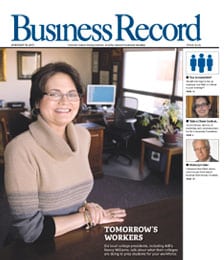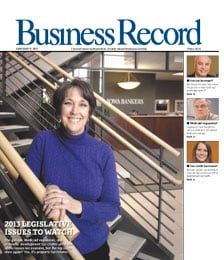Get out of the gym routine

If you dread monotonous workouts on a stationary machine at a crowded gym or worry what other people think when your trainer has you doing squats with a medicine ball, maybe it’s time to leave the gym environment.
Some personal trainers in Greater Des Moines have started training clients in private studios or their own homes and the business people who have tried it say they value the convenience, extra attention and excitement in their routines that these programs provide.
Joel Drake started working out with Tim Ives after recovering from a ruptured Achilles’ tendon. As an investment adviser with Diversified Financial Group, he had limited time to work out. But as a member and former president of the Iowa chapter of Leukemia and Lymphoma Society, Drake wanted to compete in triathlons and marathons.
“I’m 37 years old with two daughters, more than a full-time job and an active social life,” he said. “I need to have someone hold me accountable and help me maintain.”
Drake has worked out with Ives for almost four years, even after Ives left Aspen Athletic Clubs to start his personal training business, The Body Project. In May, the two men competed in a triathlon in Memphis together, and Drake will run the half marathon at the IMT Des Moines Marathon this October. Drake said he enjoys Ives’ fresh workouts, which often involve running outdoors in addition to some weight training.
“I don’t have to worry if I’m busy or not,” said Drake. “I have a set time. I get there and I know in an hour, we’re going to get everything done. There are no interruptions.”
Ives runs his business in the basement of his Beaverdale home, which includes an office and a small gym equipped with a treadmill, a stationary bike, a punching bag, free weights and two stacked multi-gyms. Ives also utilizes city streets, parks and school tracks, especially for the 25 percent of his clients who train for endurance sports. Every six weeks, Ives said, he completely revamps his program to help his clients avoid plateaus.
“I didn’t think it was necessary to have a large gym to accomplish what I needed to accomplish as a personal trainer,” Ives said. “Clients come for expertise and my accountability relationship with them and not so much for the gym and all the equipment it offers.”
Ives trains 20 people now, most of whom work out with him for an hour twice a week at $40 to $50 an hour.
Diane Hedden’s husband started training with Scott Huber six years ago after suffering several injuries. Worried about osteoporosis and wanting to stay healthy enough to water-ski, Diane Hedden started training with Huber a year later. Huber visits the couple’s home three times a week to work with them in their basement gym, which includes a treadmill, elliptical machine, stationary bike and weight set.
The Heddens, who own Midstate Distributing Co., like having a trainer come to their home because their schedule is so busy that even the time it takes to drive to the gym is more than they can afford. Plus, Hedden said, during the workout session, they fit more in without having to wait for machines or socialize.
“I like that fact that I have a deadline,” said Hedden. “I have a commitment because he’s going to be there.”
Hedden said a typical workout involves warming up for five minutes and then doing 45 minutes of weight training, alternating each session between upper body and lower body. Huber encourages his clients to do most of their cardio training on their own, but sometimes, Hedden said, they’ll go biking or he’ll have her work out on a cardio machine. She said Huber’s core training workouts have helped her become more toned and have reduced the tension that builds from sitting at a desk all day.
Huber started ABC Structural Fitness after working at a couple of gyms and deciding he wanted more freedom to create his clients’ programs. He visits the homes of 13 clients, who range in age from 28 to 92, charging $40 to $45 for each hour session. He encourages them to buy basic equipment such as weights, and brings other items such as elastic bands and medicine balls.
“A lot of my clients are very busy,” Huber said. “For them to take time to drive to the gym versus me going to their house when they get home from work, it’s a hassle for them. Doing it at their house, we work out and right when we’re done they can eat dinner.”
Rick Thompson, a partner at Gilcrest/Jewett Lumber Co., began working out with Curtis Linhart after hearing him speak about fitness at a conference.
“I really thought I would do it until I learned the routine,” he said. Instead, he has worked out with Linhart once a week for the past seven years. Thompson’s sessions with Linhart also give him the motivation to work out at his gym on other days.
“He’s disciplined,” said Thompson, “which makes me stay disciplined. He makes sure I do things right and the techniques are proper.… I just feel better. It gives me more energy to tackle the day.”
Linhart became a fitness trainer about 15 years ago. After becoming knowledgeable about fitness training, Linhart found that he didn’t like working in a gym because he always wanted to correct someone who was doing an exercise wrong. He bought his own studio and all the exercise equipment found at a typical gym and started Paragon Personal Training.
Seventy-five percent of Linhart’s training is Pilates, he said, which builds and tones muscles without making someone look bulky. Customers seeking to lose a lot of weight do cardio work as well. Although there are two other trainers at the club, Linhart said often he and his clients are the only people in the studio. He charges $65 per hour and usually sees his clients twice a week.
One of the biggest disadvantages to not working out in a traditional gym is the lack of big equipment. Linhart said setting up a full in-home gym costs several thousand dollars. But Ives said it’s possible to tackle any muscle group with an exercise close to what a gym machine would provide. Huber also said that people tend to like weightlifting machines because, “it may seem safer in the long run, but it’s easier to cheat on a machine.” He said learning how to use dumbbells correctly is more beneficial.
Because the cost of a personal trainer can be a huge investment, Ives started offering online training as well. For $35 a month, his clients can log on to his Web site to receive work out routines and can post comments that help Ives determine what they should do in upcoming workouts. Ives said some people participate in the program in addition to training with him. Ives said the problem with online training, however, is that people have to have the discipline to do the workout on their own.
When choosing a trainer, the biggest thing to keep in mind is that a personal trainer is personal. Linhart recommends talking with friends and checking the trainer’s references. Hedden, who went through three trainers before finding Huber, recommends trying someone for a couple months.
“I think a personal trainer becomes like a doctor,” she said. “It’s a person that you really depend on.”







